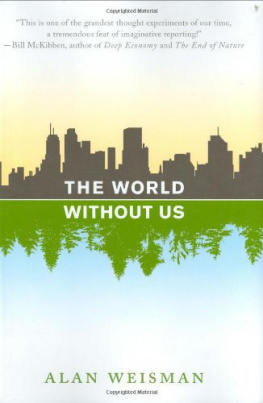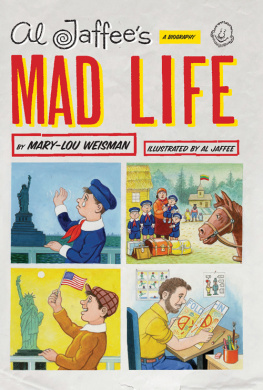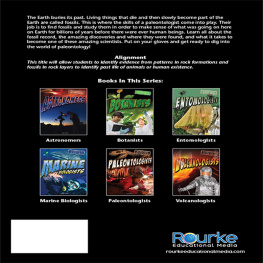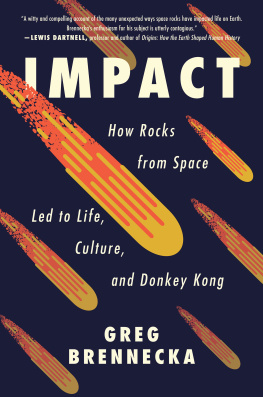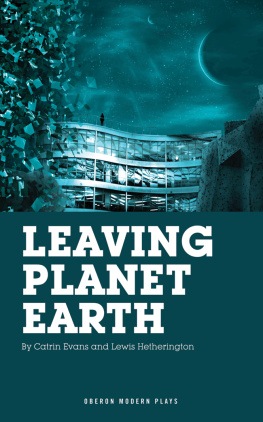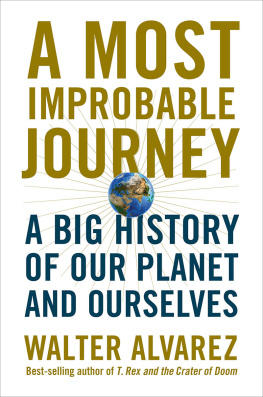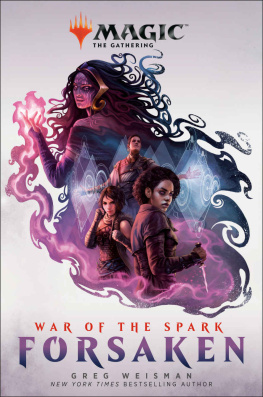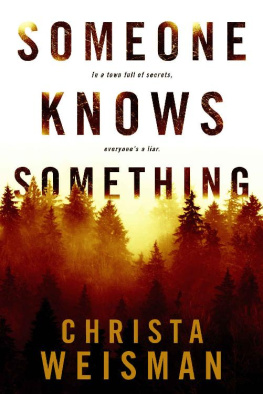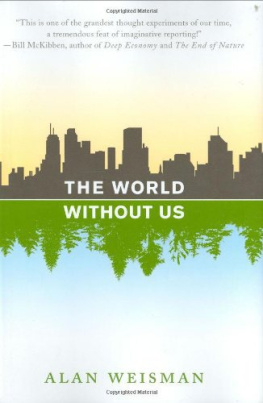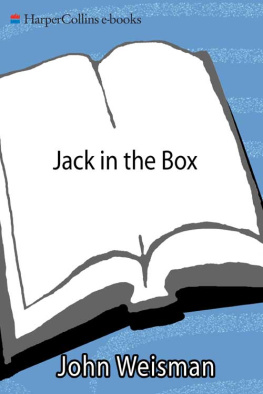
The World Without Us
ALSO BY ALAN WEISMAN
An Echo in My Blood
Gaviotas: A Village to Reinvent the World
La Front era: The United States Border with Mexico
vTHE
WORLD
WITHOUT
US

ALAN WEISMAN

THOMAS DUNNE BOOKS
ST. MARTIN S PRESS
NEW YORK
THOMAS DUNNE BOOKS.
An imprint of St. Martins Press
THE WORLD WITHOUT us. Copyright 2007 by Alan Weisman. All rights reserved. Printed in the United States of America. No part of this book may be used or reproduced in any manner whatsoever without written permission except in the case of brief quotations embodied in critical articles or reviews. For information, address St. Martins Press, 175 Fifth Avenue, New York, N.Y. 10010.
www.thomasdunnebooks.com
www.stmartins.com
Portions of this book have appeared previously
in different form in Discover Magazine and
the Los Angeles Times Magazine.
Book design by Ellen Cipriano
LIBRARY OF CONGRESS CATALOGING-IN-PUBLICATION DATA
Weisman, Alan.
The world without us / Alan Weisman.p. cm.Includes bibliographical references and index.ISBN-13: 978-0-312-34729-1ISBN-10: 0-312-34729-41. NatureEffect of human beings on. 2. Material culture. 3. Human-plant relationships. 4. Human-animal relationships. I. Title.
GF75.W4S5 2007
304.2dc22
2007011565
10 9 8 7 6 5 4
Printed on recycled paper
In memory of
Sonia Marguerite
with lasting love
from a world without you
CONTENTS

Das Firmament blaut ewig, und die Erde Wird lange fest stehn und aufblhn im Lenz. Du aber, Mensch, wie lange lebst denn du?
The firmament is blue forever, and die EarthWill long stand firm and bloom in spring.But, man, how long will you live?
Li-Tai-Po/Hans Bethge/Gustav Mahler The Chinese Flute: Drinking Song of the Sorrow of the Earth Das Lied von der Erde
The World Without Us
PRELUDE

A Monkey Koan
O
NE J UNE M ORNING in 2004, Ana Mara Santi sat against a post beneath a large palm-thatched canopy, frowning as she watched a gathering of her people in Mazraka, their hamlet on the Ro Conambu, an Ecuadoran tributary of the upper Amazon. Except for Ana Maras hair, still thick and black after seven decades, everything about her recalled a dried legume pod. Her gray eyes resembled two pale fish trapped in the dark eddies of her face. In a patois of Quichua and a nearly vanished language, Zpara, she scolded her nieces and granddaughters. An hour past dawn, they and everyone in the village except Ana Mara were already drunk.
The occasion was a minga, the Amazonian equivalent of a barn raising. Forty barefoot Zpara Indians, several in face paint, sat jammed in a circle on log benches. To prime the men for going out to slash and burn the forest to clear a new cassava patch for Ana Maras brother, they were drinking chicha gallons of it. Even the children slurped ceramic bowls full of the milky, sour beer brewed from cassava pulp, fermented with the saliva of Zpara women who chew wads of it all day. Two girls with grass braided in their hair passed among the throng, refilling chicha bowls and serving dishes of catfish gruel. To the elders and guests, they offered hunks of boiled meat, dark as chocolate. But Ana Mara Santi, the oldest person present, wasnt having any.
Although the rest of the human race was already hurtling into a new millennium, the Zpara had barely entered the Stone Age. Like the spider monkeys from whom they believe themselves descended, the Zpara essentially still inhabit trees, lashing palm trunks together with bejuco vines to support roofs woven of palm fronds. Until cassava arrived, palm hearts were their main vegetable. For protein they netted fish and hunted tapirs, peccaries, wood-quail, and curassows with bamboo darts and blowguns.
They still do, but there is little game left. When Ana Maras grandparents were young, she says, the forest easily fed them, even though the Zpara were then one of the largest tribes of the Amazon, with some 200,000 members living in villages along all the neighboring rivers. Then something happened far away, and nothing in their worldor anybodys was ever the same.
What happened was that Henry Ford figured out how to mass-produce automobiles. The demand for inflatable tubes and tires soon found ambitious Europeans heading up every navigable Amazonian stream, claiming land with rubber trees and seizing laborers to tap them. In Ecuador, they were aided by highland Quichua Indians evangelized earlier by Spanish missionaries and happy to help chain the heathen, lowland Zpara men to trees and work them until they fell. Zpara women and girls, taken as breeders or sex slaves, were raped to death.
By the 1920s, rubber plantations in Southeast Asia had undermined the market for wild South American latex. The few hundred Zpara who had managed to hide during the rubber genocide stayed hidden. Some posed as Quichua, living among the enemies who now occupied their lands. Others escaped into Peru. Ecuadors Zpara were officially considered extinct. Then, in 1999, after Peru and Ecuador resolved a long border dispute, a Peruvian Zpara shaman was found walking in the Ecuadoran jungle. He had come, he said, to finally meet his relatives.
The rediscovered Ecuadoran Zpara became an anthropological cause clbre. The government recognized their territorial rights, albeit to only a shred of their ancestral land, and UNESCO bestowed a grant to revive their culture and save their language. By then, only four members of the tribe still spoke it, Ana Mara Santi among them. The forest they once knew was mostly gone: from the occupying Quichua they had learned to fell trees with steel machetes and burn the stumps to plant cassava. After a single harvest, each plot had to be fallowed for years; in every direction, the towering forest canopy had been replaced by spindly, second-growth shoots of laurel, magnolia, and copa palm. Cassava was now their mainstay, consumed all day in the form of chicha. The Zpara had survived into the 21st century, but they had entered it tipsy, and stayed that way.
They still hunted, but men now walked for days without finding tapirs or even quail. They had resorted to shooting spider monkeys, whose flesh was formerly taboo. Again, Ana Mara pushed away the bowl proffered by her granddaughters, which contained chocolate-colored meat with a tiny, thumbless paw jutting over its side. She raised her knotted chin toward the rejected boiled monkey.
When were down to eating our ancestors, she asked, what is left?
So far from the forests and savannas of our origins, few of us still sense a link to our animal forebears. That the Amazonian Zpara actually do is remarkable, since the divergence of humans from other primates occurred on another continent. Nevertheless, lately we have had a creeping sense of what Ana Mara means. Even if were not driven to cannibalism, might we, too, face terrible choices as we skulk toward the future?
A generation ago, humans eluded nuclear annihilation; with luck, well continue to dodge that and other mass terrors. But now we often find ourselves asking whether inadvertently weve poisoned or parboiled the planet, ourselves included. Weve also used and abused water and soil so that theres a lot less of each, and trampled thousands of species that probably arent coming back. Our world, some respected voices warn, could one day degenerate into something resembling a vacant lot, where crows and rats scuttle among weeds, preying on each other. If it comes to that, at what point would things have gone so far that, for all our vaunted superior intelligence, were not among the hardy survivors?
Next page
